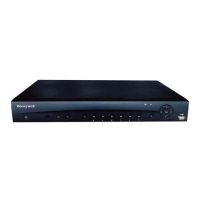
Do you have a question about the Honeywell HRHH1081 and is the answer not in the manual?
| Channels | 8 |
|---|---|
| Recording Resolution | 1080p |
| Hard Drive Capacity | 1TB |
| Compression | H.264 |
| Operating System | Embedded Linux |
| Network Interface | Ethernet |
| Video Output | HDMI, VGA |
| Power Supply | 12V DC |
| Remote Viewing | Yes |
| USB Port | USB 2.0 |
Details FCC compliance and regulatory statements for the device.
Describes the front and rear panel interfaces and connectors of the DVR.
Explains how to use the mouse for navigation and control of the DVR interface.
Details the functions and usage of the supplied IR remote control for DVR operation.
Lists the items included in the DVR package and instructions for unpacking.
Provides step-by-step instructions for connecting cameras, monitors, and other peripherals to the DVR.
Guides users on the correct procedures for powering the DVR on and off to prevent data loss.
Explains how to use the startup wizard for initial DVR configuration, including general, date/time, and network settings.
Describes the DVR's default live view mode and the multi-channel display layout.
Details how to adjust screen layouts, monitor picture settings, and customize the live view interface.
Explains how to operate Pan/Tilt/Zoom (PTZ) cameras connected to the DVR, including presets and tours.
Guides on how to manually record video clips to a USB storage device directly from the live view.
Covers configuring general record settings and scheduling for continuous or event-based recording.
Details how to search for recorded video by date and play back files using the interface controls.
Explains how to search and play back recorded snapshot images captured by the DVR.
Provides instructions for backing up recorded video and snapshot files to an external USB storage device.
Guides on how to adjust camera image parameters like saturation, brightness, contrast, and sharpness.
Details how to configure video and audio encoding parameters for camera streams.
Explains how to set up privacy masks to block specific areas in the camera view.
Describes how to assign descriptive names to connected cameras for easier identification.
Guides on how to change the channel type from Coax to UTP for different cabling setups.
Details the setup of IP addresses, subnet masks, gateways, and network ports for connectivity.
Explains how to manage Wi-Fi connections, including automatic and manual hotspot connections.
Covers advanced network configurations like PPPoE, DDNS, IP filtering, email, FTP, and UPnP.
Describes how to configure the DVR to send alarm signals to a central monitoring platform.
Details how to set up motion detection regions, sensitivity, and periods for event triggering.
Guides on configuring detection and actions for video loss events.
Explains how to configure local alarm inputs, including device type and detection periods.
Details how to configure alarm output types, such as schedule-based or manual activation.
Details how to set up schedules for recording video based on time, event type, or day.
Guides on managing hard disk drives, including changing type and formatting.
Explains how to run diagnostic tests on the DVR's hard drives to check their health.
Covers essential device settings like name, language, video standard, and HDD behavior.
Details how to adjust display settings such as transparency, time, channel display, and resolution.
Guides on configuring serial communication settings for connected RS232 devices.
Details how to configure settings for Pan/Tilt/Zoom capable cameras.
Explains how to configure overlay settings for retail environments like ATMs and POS machines.
Guides on adding, editing, and deleting user accounts, including privilege assignments.
Covers setting up automatic device reboot and old file deletion functions.
Details how to export and import DVR system configurations for backup and deployment.
Explains how to restore various system settings back to their factory defaults.
Provides instructions for upgrading the DVR's system firmware locally via USB.
Details how to view HDD status, recording information, data stream rates, and system version.
Guides on viewing event information at both device and channel levels.
Covers viewing online users, network data transmission, and performing network tests.
Explains how to view system, configuration, storage, alarm, record, and account logs.
Addresses issues like the DVR not turning on, shutting down unexpectedly, or not detecting hard drives.
Covers problems with no picture, distorted video, inability to search records, or lack of audio.
Addresses issues with motion detection not working and unstable network connections.
Describes rear panel connections for alarm inputs and outputs, and guidelines for safe wiring.
Provides step-by-step instructions for installing an additional hard disk drive into the DVR.
Lists compatible SATA hard drive manufacturers, series, models, and capacities.











